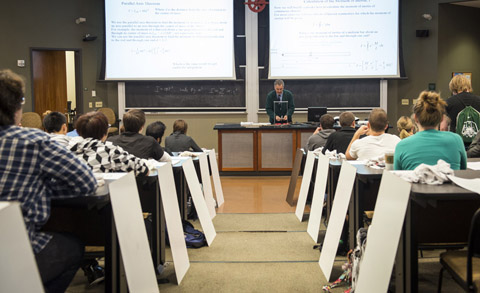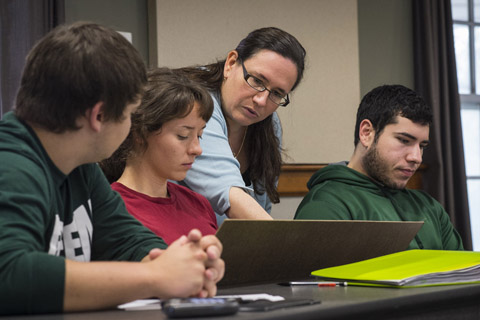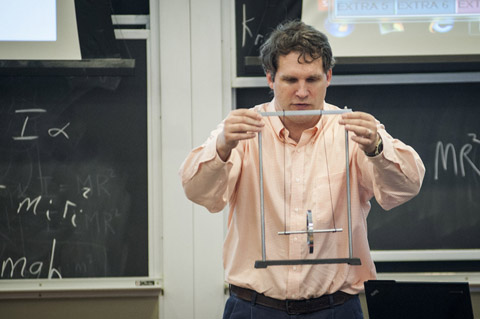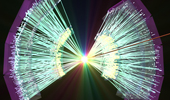By Drs. Justin Frantz, Ken Hicks and David Ingram
Physics & Astronomy
What was it like before being flipped? Here’s some background: The course General Physics had been taught in a standard lecture-style format, with a primary audience of engineering students who are required to pass it to complete their bachelor’s degree. The course is fast-paced in order to cover all of the material expected by engineering accreditation requirements. Class size is 60-100 students each, taught in three sections for a total of about 225 students per term.
In the 2013-14 academic year, our department tried a new approach to this class. We used a flipped classroom model, where the students do hands-on and group activities during class with a minimum of lecture. In the old format, lecture was done in class, and problem-solving was done primarily outside of class via homework assignments. In the new format, students are expected to read the textbook or view online lectures before coming to class, and problem-solving skills are developed during class. Hence, the name “flipped classroom.”
We are not the first university to try this approach. In the physics education literature, a popular flipped classroom format is called SCALE-UP. It was first implemented at North Carolina State University and is now adopted at many universities across the country. While our classroom is not ideal for the classic implementation of SCALE-UP, which uses round tables that seat nine students in groups of three, we adapted the classroom-style tables of our room to accommodate groups of three students each. More will be said about the groups later.
Measurement and Anecdotal Evidence
In general, we believe this format promotes better learning of the physical concepts. Although this is challenging to measure quantitatively, there is much anecdotal evidence. For example, we found that there was better attendance in the second half of the semester as compared with past experience of a standard lecture format. In addition, those students who came to class were more engaged, since they were active in group work during class rather than simply listening to the professor’s lecture. (There is an old joke that the lecture format is the fastest way to transfer the professor’s notes to the student’s notes without going through the head of either one.)
We also tried quantitative measures for student learning in the new format. A test called the Force-Concept Inventory (FCI) was given both pre-class (during the first week) and post-class (before finals) to measure the increase in learning for each student. The students were told that the FCI test was not going to be part of their grade and was simply a tool to provide feedback to the instructors. This test is multiple-choice, and the answer sheets were not processed until after final grades were submitted. Previous measurements using the FCI at other universities have shown better gain (pre-class to post-class) for the SCALE-UP format, and our results are consistent with that finding.
To get at student feedback on the flipped-classroom format, we used a paper survey given on the last day of class. A majority of the students (56 percent) had a better opinion of the new format than the lecture format. While this is not a ringing endorsement, it is worth noting that other universities have seen similar resistance to change. In fact, the students generally have to work harder in the new format, since they must read (or listen to an online lecture) before coming to class so as to be prepared for the group activities. Our survey also asked how many students had done the textbook reading assignment before coming to class, and only a third of the students did so. In order to be successful, we need to find ways to motivate the students to read the required material. However, even though many students were ill-prepared before class, they seemed to learn more during class activities than they did by simply copying the lecture material in the old format.
Coached Problem-Solving
The value of doing group activities during class is common sense. For example, to learn to play the piano, it is not sufficient to watch a good pianist; one must practice as well. Similarly, to become good at sports, it is not sufficient just to watch good athletes; one must get out onto the field and play. It works the same in the classroom: watching the professor solve physics problems on the blackboard does not make students good at solving problems. The in-class group activities provide the student with coached problem-solving, where they can raise their hand and get immediate help if they fail to work out the solution on their own. Many students were very positive about this in the survey.
While it appears that learning is better in the flipped classroom model, there are some drawbacks. For example, it requires more human resources during class. In our implementation of SCALE-UP, we had one TA for every six to seven groups. For a class of 75 students, with 25 groups, this requires about four TAs per class. The professor also circulates around the class, often helping groups where the TA is busy with another group. The same TAs helped in each of our three sections, which simplifies their preparation time. To do this, the professors teaching each section need to coordinate class planning, to do the same group activities each day. Some individuality in class preparation is lost, but this is worth it for the gain in student learning.
As this was the first time to teach General Physics in the new format, we learned some things that will hopefully make it more successful the next time around. For example, we found that it is advantageous to add more structure to the group activities. When the groups of three students are working to solve a physics problem, we ask them to write their solution on a small whiteboard using erasable marker pens. The reason for this is to make it much easier for the TA or professor to see the group’s work since it is very difficult to see their work if done by paper and pencil. We discovered that it is essential to have the person writing on the whiteboard to rotate daily, so that one group member does not always dominate the work. In addition, that writer should sit in the middle position of the group, so that both outside members can see and contribute to the work. This may seem like a small detail, but it actually makes a big difference in the group dynamics. We also found other improvements, but suffice it to say that the next time around should be better.
In summary, we had a good experience with the flipped classroom approach called SCALE-UP that has been successful at other universities. We believe this improves student learning and also increases student engagement during class. Our initial measures of improved student understanding of the physical concepts, as compared with a lecture format, are encouraging and improvements in the course delivery are expected to further increase student learning. We thank the College of Arts & Sciences for providing the encouragement and the resources necessary to implement this new format.






















Comments